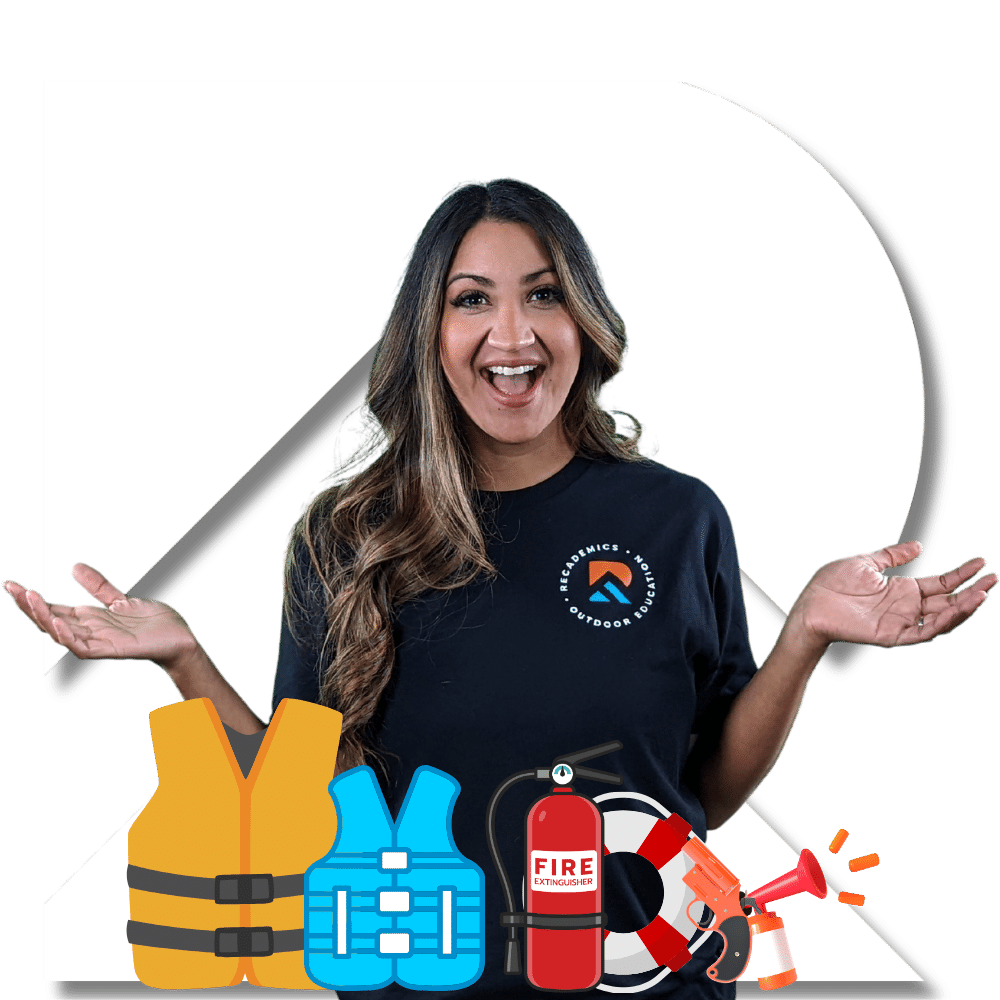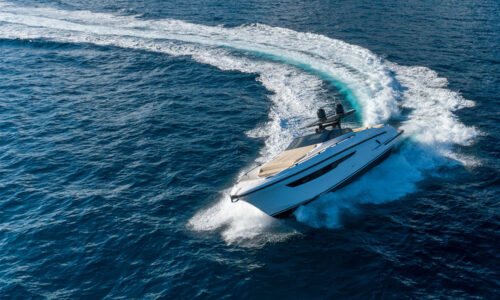What safety equipment must be on a boat?

Key Takeaways:
- Certain boat safety equipment, such as PFDs, fire extinguishers, visual distress signals, sound signaling devices, navigation lights, and other vessel-specific equipment, is required by law to be onboard your boat.
- The specific equipment required on your boat depends on the boat type and size.
- In addition to federal law, states have specific requirements
- Check the U.S. Coast Guard website and your state’s boating agency website for your specific vessel
Article Outline
- Federally Required Boat Safety Equipment
- Safety Equipment by Boat Size
- Safety Equipment Required by State Laws
- Recommended (optional) Equipment
- Factors Affecting Boat Capacity
- Safety Tips for Managing Boat Capacity
Required Equipment
The U.S. Coast Guard (USCG) requires every boat to have specific safety items. What you need depends on your boat’s size and type. Check the USCG website and your state’s regulations to find out what’s required for your boat.
Federally Required Boat Safety Equipment
Life Jackets (Personal Flotation Devices)
Throwable PFD (for boats over 16 feet)
Fire Extinguishers
Visual Distress Signals (for coastal waters)
Sound Producing Devices
Navigation Lights
Ventilation (for boats built after August 1980)
Backfire Flame Arrestor (for inboard or sterndrive gasoline engines)
Marine Sanitation Devices and placards (for boats with permanently installed toilets)
Personal Flotation Devices (Life Jacket)
Wearable PFDs
Every person on board must have a suitable, properly sized, and in good condition life jacket. These jackets are designed to keep individuals afloat in an emergency, providing crucial support until rescue can be achieved.See “Are Life Jackets Required on a Boat?”
Throwable PFDs
In addition to wearable life jackets, boats must also be equipped with throwable flotation devices if the boat is over 16 feet long. These include cushions or life rings that can be easily tossed to someone in the water, offering immediate assistance and increasing the chances of a successful rescue.Visual Signaling Devices
Flares
Flares are crucial for signaling distress and attracting attention in emergencies. They are visible over long distances and are effective in both day and night conditions. Boats should carry an adequate number of flares, ensuring they are stored in a dry, easily accessible location.
Electronic Distress Signals
Electronic distress signals offer a modern alternative to traditional flares. Devices such as Emergency Position Indicating Radio Beacons (EPIRBs) and Personal Locator Beacons (PLBs) send distress signals to rescue authorities, providing accurate location information to facilitate a timely rescue.
Fire Extinguishers
Fire extinguishers are essential safety equipment on any boat, designed to combat fires quickly and effectively. The type and number of fire extinguishers required depend on the boat’s size and the potential fire hazards present. Smaller boats typically need at least one marine-rated fire extinguisher, while larger vessels may require multiple extinguishers strategically placed throughout the boat. Regularly check the condition and charge of fire extinguishers to ensure they are ready for use in an emergency.
Sound Signaling Devices
Horns, Air Horns, Whistles
Sound signaling devices are vital for communicating with other vessels and alerting them to your presence, especially in low-visibility conditions. Every boat should be equipped with a sound signaling device, such as a horn, air horn, or whistle. These devices are used to signal intentions, alert other boaters to danger, and comply with navigational rules.
Other Required Equipment
Navigation Lights
Navigation lights are mandatory for operating a boat after sunset and during low-visibility conditions. They ensure that your vessel is visible to others, helping to prevent collisions. The specific lights required vary based on the vessel type and size.
Ventilation
Proper ventilation systems prevent the buildup of flammable gases in enclosed engine and fuel tank compartments. These systems must be maintained regularly to ensure effectiveness.
Backfire Flame Arrestors
Backfire flame arrestors are required on all gasoline engines to prevent engine backfires from causing explosions. They should be inspected and cleaned regularly.
Marine Sanitation Devices
Marine sanitation devices (MSDs) are necessary for managing waste on board, ensuring compliance with environmental regulations and maintaining hygienic conditions. Different types of MSDs are available, depending on the boat’s size and usage.
Safety Equipment by Boat Size
The equipment required on a boat varies significantly based on the boat’s size. For smaller boats, such as those under 16 feet, basic safety gear includes personal flotation devices (PFDs) for each person, nighttime visual distress signals, and a means to produce sound, like a horn or whistle. Larger boats, such as those over 26 feet, have additional requirements like more extensive fire extinguishers, more comprehensive navigation lights, pollution prevention equipment, and marine sanitation devices. As boat size increases, so do the regulations to ensure the safety and compliance of the vessel, reflecting the greater risks and operational complexities involved.
Safety Equipment Required by State Laws
In addition to federal regulations, states can also impose their own laws regarding boating safety equipment, which may include additional requirements or considerations. These state-specific regulations often address local conditions and hazards unique to the region’s waterways. For instance, some states may mandate the use of specific types of personal flotation devices for children, require additional visual distress signals for certain bodies of water, or impose stricter rules on using and maintaining fire extinguishers and navigation lights. Boaters must familiarize themselves with federal and state laws to ensure full compliance.
Recommended Boat Safety Equipment
VHF Radio and Communication Devices
A VHF radio is essential for emergency communication and weather updates. It provides a reliable means of calling for help beyond the range of cell phones.
First Aid Kit
A well-stocked first aid kit can help handle common injuries such as cuts, burns, and sprains. Ensure it includes bandages, antiseptics, pain relievers, and other necessary medical supplies.
Anchor and Line
Having a properly sized anchor and sufficient line is important for securing your boat in various conditions, preventing drift and potential accidents.
Manual Bailing Device
Manual bailing devices, such as buckets or hand pumps, are essential for dewatering the boat in case of leaks or rain accumulation.
Extra Food and Drinkable Water
Being prepared for extended stays on the water is a good idea. Carrying extra food and drinkable water ensures that everyone on board can stay hydrated and nourished in case of delays or emergencies.
Paddles or Oars (for Smaller boats)
These manual propulsion tools serve as a backup in case of engine failure or when navigating through shallow or narrow waters where the use of an engine may not be feasible. Paddles or oars provide an additional layer of safety, ensuring that the boat can still be maneuvered and controlled under various circumstances.
Boating
- Wyoming
- Wisconsin
- West Virginia
- Washington
- Virginia
- Vermont
- Utah
- Tennessee
- South Dakota
- South Carolina
- Rhode Island
- Pennsylvania
- Oregon
- Oklahoma
- North Dakota
- North Carolina
- New York
- New Mexico
- New Jersey
- New Hampshire
- Nevada
- Nebraska
- Montana
- Missouri
- Mississippi
- Minnesota
- Michigan
- Massachusetts
- Maryland
- Maine
- Louisiana
- Kentucky
- Kansas
- Iowa
- Indiana
- Illinois
- Idaho
- Hawaii
- Georgia
- Florida
- Delaware
- Connecticut
- Colorado
- California
- Arkansas
- Arizona
- Alaska
- Alabama
- Ohio
- Texas

